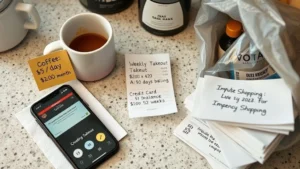Ever notice how your paycheck sometimes feels like it disappears into thin air? Like, you were sure you had enough for bills, groceries, and maybe a little fun, but somehow you’re left wondering where it all went? Yup, I’ve been there. It’s messy and frustrating, but here’s the thing: turning that “Where did all my money go?” feeling into “Hey, I’ve got this!” isn’t magic—it’s just about really understanding how you manage your money. So, grab a coffee (or your favorite drink), and let me walk you through some friendly, no-nonsense money management tips that actually make sense—and work.
Track Your Spending
Alright, first up: tracking your spending. I know it sounds like one of those annoying chores, but think of it like detective work—finding the leaks in your money boat before it sinks. When you write down or log every little purchase, including those sneaky morning coffees and late-night snacks, you start to see a pattern. And trust me, it’s eye-opening.
Here’s something I learned the hard way: one month I realized I was blowing almost $200 just on takeout. Crazy, right? Switched things up, made some meals at home, and suddenly that extra cash wasn’t just gone—it was growing. You can use apps like Mint or just an old-school spreadsheet. If you’re juggling studies or new jobs, take a peek at Money management tips for students; there are some great tools in there tailored just for you.
Which Tools Help Track Spending Best?
| Tool | Free? | Best For | Example Use |
|---|---|---|---|
| Mint App | Yes | Automatic tracking, alerts | Flags overspending on dining out |
| Spreadsheet | Yes | Custom tracking, personalized categories | Perfect for detailed budgets and Money management tips for students |
| Envelope System | Yes | Cash-only budgeting, visual control | Divide money into physical envelopes for categories |
Cutting Costs Without Missing Out
Now, here’s the million-dollar question: can you really cut costs without feeling like you’re missing out? The short answer? Absolutely. Those little expenses add up faster than you think—subscriptions you forgot about, random takeouts, unnecessary late fees… all chip away at your wallet.
Try trimming back 10-20% of your monthly spending by cutting or switching some services. How about negotiating bills like your cable or internet? I’ve done it twice and saved a bunch. No harm in asking.
Swaps That Save
| Expense | Costly Habit | Frugal Swap | Savings Estimate |
|---|---|---|---|
| Lunch Out | $15/day | Packed Sandwich | $300/month |
| Streaming Services | 3 subs ($45) | One Shared Plan | $30/month |
| Coffee Run | Daily $5 latte | Home Brew | $100/month |
And here’s something cool—my friend ditched multiple streaming subscriptions and got hooked on free public library ebooks and movies instead. She ended up saving enough for a weekend getaway! What do you think, worth a try?
Build Your Emergency Buffer
Let’s talk about that emergency fund—the financial safety net everyone says is important but can feel impossible to build.
Here’s the deal: aim to save 3-6 months of essential expenses like rent, utilities, and food. Don’t freak out; start small. Even setting aside $20 from each paycheck adds up over time. Automate it—your bank probably has an easy transfer option to a savings account, and you won’t even miss it.
Want more on this? You might like these money management tips that break it down simply.
Steps to Start Your Buffer
- Figure out your basic monthly costs (rent, bills, groceries).
- Multiply by 3 months as your starter goal.
- Set up automatic weekly or monthly savings transfers.
- Watch it grow using compound interest—your money earns money! (fun, right?)
Once, a car repair wiped out my card balance—total stress. But that emergency fund? Covered it, stress-free. Trust me, it’s worth the effort.
Tackling Debt Smartly
Debt… the word alone can make you cringe. But tackling it systematically will get you free sooner than you think.
High-interest debt (hello, credit cards) should be your first target. The “snowball method” means you start by paying off the smallest debt first to get some quick wins, while the “avalanche method” saves you money on interest by targeting the highest interest rates first. Both work, pick the one that keeps you motivated.
If you’re curious about tools to help, there are plenty of calculators and guides with Free money management tips designed to make paying down debt less daunting.
Snowball vs. Avalanche
| Method | Focus | Best if | Benefit |
|---|---|---|---|
| Snowball | Smallest Debt First | You need motivation | Quick wins build momentum |
| Avalanche | Highest Interest First | Saving interest is priority | Less money paid in interest long term |
Fun fact: a friend of mine cleared three credit cards in six months using snowball, then rewarded herself with a debt-free pizza night. Small celebrations count!
Saving For The Long Haul
Retirement savings… sounds so far away, right? But starting now means your money has time to grow with compound interest, and trust me, that math is powerful.
Even stashing away 5% of your income monthly can snowball into a decent retirement pot. Check out options like 401(k)s or IRAs, and if you’re just starting out, Money management tips for young adults often emphasize grabbing employer matches—free money, people!
Beginner-Friendly Options
| Option | Risk | Why Try? | Example |
|---|---|---|---|
| High-Yield Savings | Low | Safe emergency + short goals | ~4% annual interest |
| Index Funds | Medium | Long-term growth | S&P 500 average 7-10% returns |
The earlier you start, the more time your money has to work for you. Starting at 25 instead of 35 can double your savings by retirement age. I wish I’d known that in my twenties!
Fee-Proof Your Finances
Let’s face it—fees are the worst. Overdraft, late payment, ATM charges—they sneak in and steal your hard-earned cash faster than you notice.
Best bet? Set up bill reminders or auto-payments so you’re always on time. Use debit cards for daily spends so you’re not accidentally racking up interest charges. Quarterly bank statement checks can catch unexpected fees before they pile up.
Common Fees & How to Dodge Them
- ATM Fees: Stick to your bank’s network or no-fee ATMs—to save $3 or more per withdrawal.
- Late Payment Fees: Use automatic bill pay for essentials like rent and utilities—the easiest way to avoid costly late fees.
One time, I ignored my bill due date and racked up $50 in overdraft fees. Lesson learned. Now, alerts keep me on track, and that stress? GONE.
Boost Income With Hustles
If your expenses tend to be more than your income—don’t panic. Side hustles can be a game-changer.
Whether it’s pet sitting, online surveys, tutoring, or weekend baking gigs, adding an extra $200 monthly can make a huge difference in freeing up your budget.
Pair this mindset with these money management tips, and you’re setting yourself up for success beyond just saving money.
Easy Side Hustle Ideas
| Idea | Time | Potential Earnings | Startup Cost |
|---|---|---|---|
| Pet Sitting | Weekends | $20/hour | Minimal (apps like Rover) |
| Online Surveys | Evenings | $50-$100/month | None |
| Tutoring | Flexible | $25/hour | Skills-based |
Personally, my weekend baking hustle covered my grocery bills. Tasty and practical.
Adjust For Life Changes
Life is messy and unpredictable. Getting married? Having kids? Lost a job? It all means your financial plan needs a tune-up.
If you’re studying or just starting out, focus on basics—you can learn loads from Money management tips for students. As your life shifts, revisit your budget and savings goals to keep pace.
Stage-Specific Money Tips
- Young Adult/Student: Build emergency savings fast and focus on tackling high-interest debt.
- Started Family: Look into child-related savings and reconsider discretionary spending.
When my partner and I had our first kid, we had to seriously cut some fun expenses—but those creative daycare swaps saved us $300 a month. Worth it!
Use Resources That Help
Honestly, budgeting isn’t as scary when you have the right tools. There are heaps of free resources, planners, and calculators out there. Canada’s Budget Planner and free budgeting PDFs from trustworthy sites are great places to start.
Integrate what you like and watch your financial confidence grow. Many Free money management tips include simple apps and worksheets that do the math and give you easy-to-understand visuals. Perfect for folks who aren’t math whizzes.
Wrapping It Up
So, those are some solid, down-to-earth money management tips that I wish someone had told me years ago. The biggest secret? Start small, track your spending like a detective, cut back here and there without feeling deprived, and gradually build your savings and financial security.
Pick one or two tips from here—maybe review your subscriptions or set up an automatic $20 transfer to savings—and try it this week. Small steps lead to big wins and, honestly, that feeling of control over your money? Absolutely worth it.
If you want more, dive into some Money management tips for young adults—they’re packed with ideas that feel doable. Now, take a deep breath, glance at your last bank statement, and make one friendly change.
Your future self (and wallet) will thank you. Ready for that? Let’s do this.













